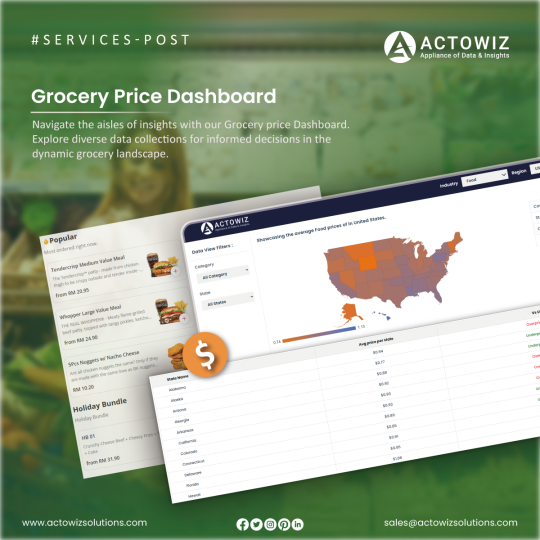#GroceryDataScraper
Explore tagged Tumblr posts
Text

Knoe More >> https://www.actowizsolutions.com/grocery-delivery-data-scraping.php
#GroceryDataScraping#GroceryDataScraper#GroceryDataExtractor#SupermarketDataExtraction#RetailDataScraping#GroceryDataAnalysis#MarketDataScraping#SupermarketInsights#GroceryMarketData#RetailIntelligence#SupermarketScraping#DataDrivenRetail#ProductDataExtraction#RetailDataSolutions#EcommerceDataExtraction#MarketIntelligence#DataScrapingSolutions#RetailDataAnalytics#SupermarketAnalysis#GroceryMarketInsights#RetailMarketData#GroceryRetailData#SupermarketDataSolutions
0 notes
Text
#ScrapingGroceryDataFromSwiggyInstamart#WebScrapingGroceryDataFromSwiggyInstamart#SwiggyInstamartGroceryDataExtraction#WebScrapingForFoodDelivery#WebScrapingQuickCommerceData#ScrapingGroceryDeliveryData#GroceryDataScraper
0 notes
Text
Scrape Blinkit Grocery Data | Enhancing Online Retail Strategie
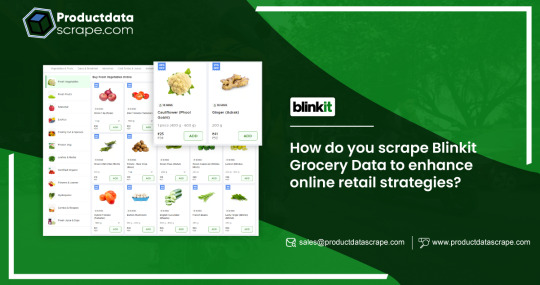
Grocery data scraping plays a pivotal role in the modern retail and consumer behavior analysis landscape. It involves automated data extraction from various online grocery platforms, providing valuable insights into pricing trends, product availability, customer preferences, and overall market dynamics.
In today's highly competitive market, where the demand for online grocery shopping is rising, businesses can leverage grocery data scraping services to gain a competitive edge. One such example of grocery delivery business is Blinkit. Scrape Blinkit grocery data to enable real-time information collection from multiple sources, allowing retailers to monitor their competitors, optimize pricing strategies, and ensure their product offerings align with customer demands.
The role of grocery data scraping services extends beyond pricing and product information. They facilitate the analysis of customer reviews, helping businesses understand the sentiments and preferences of their target audience. By harnessing this data, retailers can enhance their marketing strategies, tailor promotions, and improve overall customer satisfaction.
Furthermore, grocery data scraping services contribute to inventory management by providing insights into stock levels, identifying fast-moving items, and predicting demand fluctuations. This proactive approach allows businesses to optimize their supply chains, minimize stockouts, and ensure efficient operations.
In essence, scrape grocery data to stay agile in the competitive grocery industry, offering businesses the tools to make informed decisions, enhance customer experiences, and ultimately thrive in the ever-evolving retail landscape.
List Of Data Fields
Product Information:

Product name
Brand
Category (e.g., fruits, vegetables, dairy)
Description
Price
Inventory Details:

Stock levels
Availability Status
Unit measurements (e.g., weight, quantity)
Pricing Information:

Regular price
Discounted price (if applicable)
Promotions or discounts
Customer Reviews:

Ratings
Reviews
Customer feedback
Delivery Information:

Delivery options
Shipping fees
Estimated delivery times
Store Information:
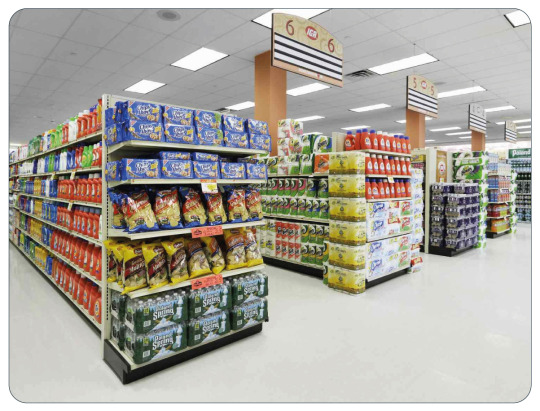
Store name
Location details
Operating hours
Images:
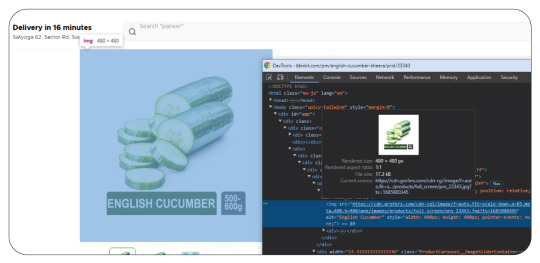
URLs or image data for product pictures
Promotional Information:
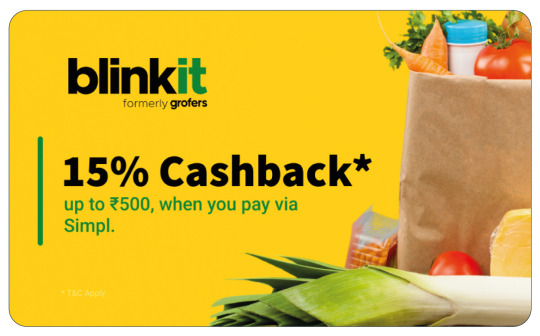
Promo codes or special offers
Limited-time discounts
Product Attributes:
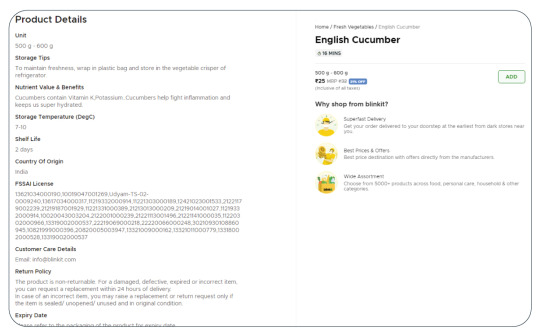
Nutritional information
Ingredients
Allergen information
User Account Information:
User profiles (if accessible and in compliance with privacy policies)
Order history
About Blinkit
Blinkit, a prominent grocery delivery app in India, offers a streamlined shopping experience, allowing users to order a diverse array of groceries online conveniently. Prioritizing ease, Blinkit empowers customers to effortlessly browse and select products via its platform, ensuring doorstep delivery. The app can simplify grocery shopping, granting users access to various essentials. For the most up-to-date details on Blinkit, users are encouraged to visit the official website or consult app descriptions and reviews on relevant platforms.
Utilize Blinkit grocery delivery app data scraping to acquire real-time insights, including product details, pricing dynamics, inventory status, and customer feedback. This data-driven approach enables businesses to stay competitive, optimize pricing structures, enhance inventory strategies, and grasp consumer preferences for well-informed decision-making in the ever-evolving landscape of online grocery retail.
Significance Of Scraping Blinkit Grocery Data
Enhance User Experience: By scraping Blinkit Grocery Delivery data, businesses can provide users with real-time updates on product availability, ensuring a seamless and satisfying shopping experience. Accurate information contributes to increased customer trust and satisfaction.
Competitive Pricing Strategies: Accessing Blinkit's pricing data through scraping allows businesses to gain insights into dynamic pricing strategies. This knowledge helps formulate competitive pricing structures, stay agile in the market, and adapt to changes in consumer behavior.
Optimized Stock Management: Scrape Blinkit grocery data to help businesses monitor stock levels efficiently. This data-driven approach aids in preventing stockouts, optimizing inventory turnover, and ensuring that customers consistently find the products they need.
Quality Improvement: Analyzing customer reviews extracted through Blinkit grocery data scraping services provides valuable insights into consumer preferences and concerns. This information helps businesses identify areas for improvement, enhancing the quality of products and services to meet customer expectations.
Market Intelligence: By continuously scraping data from Blinkit, businesses gain a competitive edge by staying informed about competitors' offerings, promotional strategies, and overall market dynamics. This knowledge is crucial for strategic decision-making and maintaining a solid market position.
Informed Business Strategies: The data collected from Blinkit using a grocery data scraper facilitates informed decision-making. Businesses can strategize based on insights into product popularity, consumer behavior, and market trends, ensuring their actions align with current market demands.
Market Adaptation: Regularly updated insights from scraping Blinkit data enable businesses to adapt to evolving market trends and consumer preferences. This adaptability is crucial for staying relevant and meeting the dynamic demands of the online grocery retail landscape.
Personalized Shopping: Utilizing scraped data allows businesses to personalize the user experience on Blinkit. It includes tailoring recommendations, promotions, and overall interactions, creating a more engaging and efficient user shopping journey.
What Types Of Businesses Are Benefitting From Scraped Blinkit Grocery Data?
Various businesses can benefit from scraped Blinkit grocery data, leveraging the insights for strategic decision-making, market analysis, and improved customer experiences. Here are some examples:
Online Grocery Retailers: Businesses operating in the online grocery sector can use scraped Blinkit data to stay informed about product trends, pricing strategies, and customer preferences. It enables them to optimize their own offerings and pricing structures.
Competitive Intelligence Firms: Companies specializing in competitive intelligence benefit from scraped Blinkit data to provide detailed market analyses to their clients. It includes tracking competitors' product portfolios, pricing dynamics, and promotional activities.
Market Research Agencies: Market research agencies use scraped Blinkit data to gather insights into consumer behavior, preferences, and trends in the online grocery sector. This information is valuable for producing comprehensive market reports and industry analyses.
Price Comparison Platforms: Platforms that offer price comparison services leverage scraped Blinkit data to provide users with accurate and real-time information on grocery prices. It helps consumers make informed decisions when choosing where to shop.
Data Analytics Companies: Businesses specializing in data analytics use Blinkit grocery data to perform in-depth analyses, identify patterns, and derive actionable insights. These insights contribute to data-driven decision-making for various industries.
Supply Chain Management Companies: Companies involved in supply chain management can utilize Blinkit data to optimize inventory levels, track product availability, and enhance their overall logistics and distribution strategies.
Marketing and Advertising Agencies: Advertising agencies leverage scraped Blinkit data to tailor promotional campaigns based on current market trends and consumer preferences. It ensures that marketing efforts are targeted and effective.
E-commerce Platforms: E-commerce platforms can integrate Blinkit data to enhance their grocery product offerings, optimize pricing strategies, and provide users with a more personalized shopping experience.
Startups in the Grocery Sector: Startups looking to enter or innovate within the grocery sector can use scraped Blinkit data to understand market dynamics, consumer behavior, and areas of opportunity. This information supports their business planning and strategy development.
Conclusion: Blinkit grocery data scraping provides many actionable insights for businesses across various sectors. The data extracted is valuable, from online grocery retailers optimizing their product offerings to competitive intelligence firms offering detailed market analyses. Market research agencies gain a deeper understanding of consumer behavior, while price comparison platforms offer users real-time information. Data analytics companies uncover patterns, aiding data-driven decision-making, and supply chain management firms optimize logistics. Marketing agencies tailor campaigns, and e-commerce platforms enhance their grocery offerings. Startups leverage Blinkit data for informed market entry. However, ethical considerations and adherence to legal standards remain paramount in using scraped data.
Product Data Scrape operates with a foundation in ethical standards, offering services such as Competitor Price Monitoring and Mobile Apps Data Scraping. We guarantee clients exceptional and transparent services, catering to diverse needs on a global scale.
#ScrapeBlinkitGroceryData#BlinkitGroceryDataScraping#GroceryDataScraper#ExtractBlinkitGroceryData#BlinkitDataScraper#BlinkitDataCollection
0 notes
Text
Kroger Grocery Data Scraping | Kroger Grocery Data Extraction
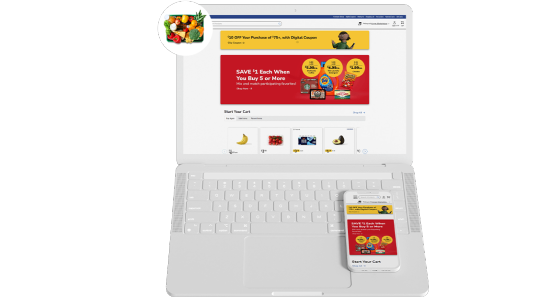
Shopping Kroger grocery online has become very common these days. At Foodspark, we scrape Kroger grocery apps data online with our Kroger grocery data scraping API as well as also convert data to appropriate informational patterns and statistics.
#food data scraping services#restaurantdataextraction#restaurant data scraping#web scraping services#grocerydatascraping#zomato api#fooddatascrapingservices#Scrape Kroger Grocery Data#Kroger Grocery Websites Apps#Kroger Grocery#Kroger Grocery data scraping company#Kroger Grocery Data#Extract Kroger Grocery Menu Data#Kroger grocery order data scraping services#Kroger Grocery Data Platforms#Kroger Grocery Apps#Mobile App Extraction of Kroger Grocery Delivery Platforms#Kroger Grocery delivery#Kroger grocery data delivery
2 notes
·
View notes
Text
How Can Scraping On-Demand Grocery Delivery Data Revolutionize The Industry?

In recent years, technology has greatly changed how we get groceries delivered to our doorstep. Businesses using web scraping can learn a lot about how people shop for groceries online. This information helps them make intelligent choices, customize their services to people's wants, and make customers happier. Imagine your grocery delivery. The app predicts your needs before you know them. When you use grocery delivery apps, it can help you. A bundle of data is being compiled in the background. That's the power of data scraping.
The ease and accessibility of online grocery delivery solutions have changed how individuals buy groceries. This eliminates the requirement for journeys to nearby stores. This business is flourishing, with an expected 20% annual revenue increase between 2021 to 2031. Orders on well-known websites like Amazon Fresh, InstaCart and DoorDash are rising significantly. However, collecting data on on-demand grocery delivery has led to the emergence of other data-scraping businesses.
What is On-Demand Grocery Data?
Grocery delivery app data scraping means all the information gathered from how on-demand grocery delivery services work. These services have transformed the buying behavior of customers and deliver them quickly to their door. The data includes different parts of the process, like what customers order, how much, where it's going, and when they want it delivered. This data is essential to make sure orders are correct and delivered on time. So, looking at on-demand grocery delivery app data scraping helps understand how people shop for groceries.
By collecting information from grocery data, businesses can see what customers are doing, keep an eye on product prices, and know about different products and special deals. This helps businesses run more smoothly daily, make smarter decisions, stay aware of prices, and give them an advantage over others.
What is the Significance of Scraping On-Demand Grocery Delivery Data?
Businesses scrape on-demand grocery delivery data as a significant boost to the industry. It is a tool that makes everything work smoother and more innovative. When businesses scrape data, they get the most up-to-date and accurate information. For example, they can know current prices, available products, and customers' preferences.
This is crucial since the grocery segment is undergoing rapid change. Scraping grocery data enables businesses to change and swiftly become incredibly efficient. They can keep ahead of the game by regularly monitoring what their competitors are doing, giving them a significant advantage over other firms. This helps not just enterprises but also customers. Companies may use scraped data to guarantee that our groceries come faster, at better prices, and with a more personalized shopping experience.
Businesses are able to make well-informed decisions by extracting grocery data because they have detailed knowledge of the market. Imagine knowing which store has the best prices or always has your favorite products in stock. Scraping helps companies figure this out. They can adjust their prices in real time to stay competitive and offer us the best discounts.
Grocery delivery app data scraping helps firms identify what their consumers like. They may learn about our tastes by reading our reviews, ratings, and comments. This implies companies may modify their goods to meet our preferences, making our purchasing experience more personalized. It acts as a virtual shopping assistant that understands just what you prefer.
Benefits of Scraping On-Demand Grocery Delivery Data

Businesses are able to scrape grocery delivery app data that offers several benefits to firms in this ever-changing market. Gathering and evaluating data from these services provides several opportunities for improvement.
Getting the correct prices
Assume you're in a race and want to ensure you're running at the same pace as everyone else. At the store, they aim to ensure the pricing is competitive with other stores. It works similarly to a speedometer for our prices by providing real-time information on other retailers' charges. If we observe competitors moving quicker (charging less), we might accelerate (reducing our rates) to stay in the race.
Consumer Behavior Evaluation
Businesses can learn a lot from customer reviews and ratings. They can gather this information in real-time and adjust their offerings to meet customer needs and expectations better. Scraping grocery delivery app data helps make customers happier and more loyal.
Delivering Faster and Smarter
We want to find the fastest way to the park and the most efficient way to deliver groceries. Finding efficient and fast delivery methods is like finding the quickest paths to the park. This saves fuel and time. It also helps the environment and makes delivery faster.
Competitor Analysis
In our store, we want to know what other stores are doing so we can make the right moves, too. Watching what other stores are doing helps to understand the actions of competitors. If we see something new or changing in the grocery market, we can make intelligent decisions and stay ahead of the competition.
Enhanced Customer Experience
Imagine having all your favorite snacks whenever you want. We want our store to have what our customers want so they are happy. We always offer what customers want, just like having a snack cabinet full of all your favorites. Customers like shopping with us, and we deliver their items as quickly as possible to make them even happier.
Operational Efficiency
Nowadays, we want the computer to assist us with our shop operations. Imagine having a robot companion who assists you with your duties. Similarly, we want the computer to assist us with our shop operations.
Future Trends of On-Demand Grocery Delivery Data

AI, machine learning, blockchain, and regular grocery data scraping can give us more detailed information. We can use this information to ensure we collect data fairly and sustainably from grocery delivery and grocery apps.
Advanced Machine Learning and AI Integration:
Organizations can enhance the processing of on-demand grocery delivery data scraping using advanced machine learning and AI. This improves automation and sophistication. It also offers valuable insights and predictive analytics to help with decision-making.
Predictive demand forecasting
Businesses can use historical and also real-time information to predict future demand. This improves management of inventory and helps forecast high-demand periods. It also ensures enough resources to meet consumer expectations.
Enhanced personalization
Using scraped data to provide highly tailored suggestions and experiences to each consumer. Tailoring on-demand delivery services to unique interests and habits will help boost consumer loyalty and happiness.
Geospatial Intelligence for Efficient Delivery
Businesses use location information, such as maps and real-time data, to help drivers find the best and fastest routes. This is similar to how your GPS guides you to the quickest way to a friend's house. Businesses use this location data to plan to improve delivery routes in real-time.
Blockchain in Data Security
Using blockchain technology can improve the security of the information we gather. As concerns about data security rise, blockchain emerges as a highly secure and trustworthy solution. It protects the acquired data from manipulation and guarantees accuracy and reliability.
Conclusion
Web scraping can have a big impact on the fast-changing, on-demand grocery delivery industry. It lets businesses get the most current information to make smart decisions and improve their operations. This technology also helps businesses to stay updated about their competition. The industry depends on data. Grocery data scraping will change how we shop for essential items. Web Screen Scraping assists in making the experience smoother and more personalized approach to scrape grocery delivery app data. Grocery delivery services can use data to create a personalized and efficient shopping experience. They are leaders in the digital changes happening in retail.
0 notes
Text
How Amazon Fresh Data Scraping and Walmart Grocery Data Scraping Drive Business Growth?

Introduction
The grocery industry has undergone a seismic shift towards digital platforms, with giants like Amazon Fresh and Walmart leading the charge. Businesses looking to stay competitive need actionable insights derived from these platforms. Amazon Fresh data scraping and Walmart grocery data scraping are powerful tools that enable businesses to gather essential data, analyze trends, and make informed decisions.
In this blog, we will explore how these practices help businesses grow, adhere to Google’s E-E-A-T (Experience, Expertise, Authoritativeness, Trustworthiness) guidelines, and ensure ethical and effective use of data scraping techniques.
What Are Amazon Fresh Data Scraping and Walmart Grocery Data Scraping?
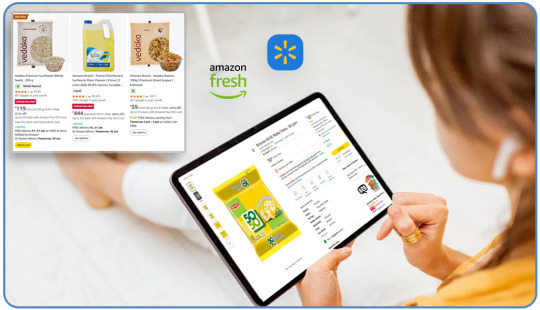
Amazon Fresh data scraping and Walmart grocery data scraping involve extracting structured data from these e-commerce platforms to gain valuable insights. These processes collect information such as product prices, availability, descriptions, customer reviews, and category details. Businesses leverage this data to understand market trends, optimize pricing strategies, and enhance their offerings.
For Amazon Fresh, data scraping enables businesses to track dynamic pricing, monitor competitor behavior, and identify high-demand products. Retailers often use Amazon Fresh price comparison tools to adjust their pricing strategies in real-time and remain competitive. Similarly, Walmart grocery data scraping provides insights into customer preferences, regional trends, and promotional strategies, helping businesses align their operations with market demands.
Both techniques are essential for businesses aiming to stay ahead in the rapidly evolving grocery industry. By implementing grocery market data extraction, companies can identify seasonal trends, popular products, and pricing fluctuations. Furthermore, scraping grocery product data helps improve inventory management and supply chain efficiency.
Ethical and compliant data scraping ensures that businesses maintain trust and adhere to legal standards. With the right tools and strategies, companies can harness the power of e-commerce grocery data scraping to fuel growth and innovation in the competitive grocery marketplace.
Benefits of Grocery Data Scraping for Grocery Businesses

In today’s competitive grocery industry, data has become a vital resource for decision-making. Amazon Fresh data scraping and Walmart grocery data scraping provide grocery businesses with a wealth of information to optimize operations, enhance customer satisfaction, and drive growth. Here’s how Grocery Data Scraping benefits businesses:
1. Real-Time Pricing Insights
By scraping grocery prices online, businesses can access real-time pricing data from platforms like Amazon Fresh and Walmart. This allows for dynamic pricing strategies that align with market demands. Tools such as Amazon Fresh price comparison tools enable retailers to adjust their prices to compete effectively, ensuring they attract price-sensitive customers while maintaining profitability.
2. Trend Analysis and Demand Forecasting
Grocery market data extraction helps businesses identify emerging trends and seasonal patterns. For instance, Walmart grocery trends analysis can reveal popular products during specific times of the year, such as holiday seasons or back-to-school periods. Retailers can use this data to stock high-demand items and plan promotions accordingly, maximizing sales opportunities.
3. Enhanced Product Offerings
Through scraping grocery product data, businesses can analyze product popularity and customer preferences. This helps retailers expand their product range by introducing in-demand items and phasing out underperforming products. Data derived from online grocery store data scraping ensures that retailers cater to evolving customer needs, enhancing their competitive edge.
4. Improved Inventory Management
By leveraging E-commerce grocery data scraping, businesses can monitor inventory levels and avoid overstocking or understocking. For example, analyzing stock availability on Amazon Fresh and Walmart ensures retailers meet customer demands without incurring unnecessary costs. Efficient inventory management reduces waste and optimizes supply chain operations.
5. Competitive Benchmarking
Amazon Fresh data scraping and Walmart grocery data scraping provide businesses with insights into competitors’ pricing, promotions, and product launches. This data enables effective competitive benchmarking, empowering businesses to create strategies that differentiate them in the market.
6. Personalized Marketing Strategies
With grocery insights data extraction, businesses gain a deeper understanding of customer behavior and preferences. This data enables personalized marketing campaigns that resonate with target audiences, improving customer engagement and loyalty.
By adopting ethical and compliant data scraping practices, grocery businesses can unlock the full potential of scraping grocery prices online and grocery market data extraction to drive growth, improve operational efficiency, and stay ahead in the e-commerce grocery landscape.
Use Cases of Grocery Data Scraping in Grocery Business Growth

Grocery data scraping has become a cornerstone for business growth in the competitive e-commerce market. By utilizing techniques such as Amazon Fresh data scraping and Walmart grocery data scraping, grocery businesses can unlock actionable insights to enhance operations, improve customer satisfaction, and boost revenues. Below are some impactful use cases:
1. Dynamic Pricing Strategies
Real-time scraping grocery prices online allows businesses to monitor competitor pricing and adjust their own prices accordingly. For example, using Amazon Fresh price comparison tools, retailers can dynamically set prices to attract cost-conscious customers while maintaining profit margins. Similarly, Walmart grocery trends analysis helps businesses understand regional pricing fluctuations, enabling localized pricing strategies.
2. Trend Identification and Demand Forecasting
Grocery market data extraction enables businesses to identify seasonal trends and predict customer demand. By analyzing historical data from platforms like Amazon Fresh and Walmart, businesses can uncover patterns, such as increased demand for specific products during holidays. Leveraging grocery insights data extraction, companies can align their inventory and marketing strategies with forecasted trends, ensuring they meet customer expectations.
3. Product Development and Catalog Expansion
Through scraping grocery product data, businesses can analyze which products are popular and in high demand. This data allows for the introduction of new product lines or categories that cater to evolving customer preferences. For instance, online grocery store data scraping can highlight trends like increasing demand for organic or plant-based products, guiding businesses to expand their offerings accordingly.
4. Inventory Optimization
Efficient inventory management is critical for grocery businesses. By implementing E-commerce grocery data scraping, retailers can track product availability and avoid stockouts or overstocking. Monitoring inventory on Amazon Fresh and Walmart ensures that businesses maintain optimal stock levels, reducing waste and improving supply chain efficiency.
5. Competitive Benchmarking and Market Positioning
Amazon Fresh data scraping and Walmart grocery data scraping provide valuable insights into competitors’ pricing strategies, promotions, and new product launches. This data empowers businesses to benchmark their offerings against competitors, refine their strategies, and create unique value propositions for their customers.
6. Personalized Marketing Campaigns
With scraping grocery prices online and grocery insights data extraction, businesses can analyze customer preferences and behavior. These insights enable the creation of tailored marketing campaigns that resonate with target audiences, leading to increased customer engagement and loyalty.
By leveraging these use cases, businesses can harness the full potential of grocery market data extraction and thrive in the ever-evolving e-commerce grocery landscape.
Ethical Considerations and Best Practices

Experience: Demonstrate practical application by showcasing real-world use cases like the ones above.
Expertise: Use advanced tools and methodologies like Python-based scraping libraries (e.g., BeautifulSoup, Scrapy) to extract data efficiently.
Authoritativeness: Cite reputable sources and use verified tools for scraping grocery prices online.
Trustworthiness: Ensure compliance with legal frameworks and platforms’ terms of service.
Adopting these guidelines not only ensures ethical practices but also protects businesses from potential legal ramifications. Maintaining transparency in data collection and usage fosters trust among stakeholders and customers alike.
Tools and Technologies for Data Scraping
Popular Tools for Grocery Data Scraping
ToolFeaturesBeautifulSoupSimplifies HTML and XML parsingScrapyProvides robust crawling frameworksSeleniumAutomates browser interactions for dynamic pages
These tools simplify the process of E-commerce grocery data scraping, enabling businesses to collect and analyze large datasets efficiently. Combining these tools with data analytics platforms can further enhance decision-making capabilities.
How Can Web Data Crawler Can Help Grocery Businesses?

Web Data Crawler can significantly benefit grocery businesses by streamlining data collection and analysis processes. Here’s how we can help:
Data Collection
Real-Time Market Insights
Improved Operational Efficiency
Enhanced Customer Experience
Scalability and Flexibility
By integrating our Web Data Crawler into your operations, we help you stay competitive, make informed decisions, and seize market opportunities. Get in touch with us today to explore tailored data scraping solutions for your grocery business!
Conclusion
Harnessing Amazon Fresh data scraping and Walmart grocery data scraping empowers businesses with actionable insights, enabling them to stay competitive in the fast-paced e-commerce landscape. From grocery market data extraction to scraping grocery product data, the opportunities for growth are immense.
Use Web Data Crawler to unlock the full potential of online grocery data. Contact our team today for tailored data scraping solutions that drive business success.
Originally published at https://www.webdatacrawler.com.
#AmazonFreshDataScraping#WalmartGroceryDataScraping#GroceryDataScraping#EcommerceGroceryScraping#ScrapingGroceryPricesOnline#GroceryMarketDataExtraction#GroceryProductDataScraping#OnlineGroceryStoreScraping#AmazonFreshPriceComparison#WalmartGroceryTrends
0 notes
Text

Source: https://www.retailscrape.com/bigbasket-grocery-data-scraping.php
#bigBasketgrocerydata#grocerydatascraping#scrapebigBasketgrocerydata#bigbasketgrocerydeliverydatascraping
0 notes
Text
Get Grocery Datasets From Different Resources
Access Grocery datasets from top marketplaces like Kroger and Instacart, detailing Store/Grocer name, address, city, and state. Pricing starts at $1,000.
#GroceryDatasets#ScrapeGroceryDataInsights#GroceryDataScraping#GroceryDataCollection#GroceryDataExtractor
0 notes
Text
How To Scrape MilkBasket Grocery Delivery App Data?
You can easily use MilkBasket Grocery delivery data scraping to get a clear and valued database, including different Grocery delivery data, reviews, locations, menus, mentions, etc.
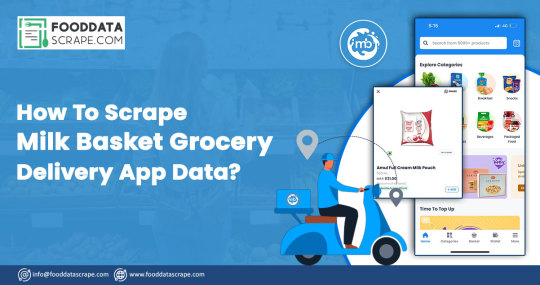
#ScrapeMilkBasketGroceryDeliveryAppData#MilkBasketGroceryDeliveryAppDataScraping#scrapeMilkBasketGroceryCompetitiveMenuPricesData#GroceryDataScrape
0 notes
Text

Our AI Analytics optimized pricing for 200 stores. Grocery data scraping streamlined operations, boosting profitability with strategic pricing adjustments.
Know more: https://www.iwebdatascraping.com/grocery-data-scraping-achieve-accuracy-across-stores.php
#GroceryDataScraping#GroceryDataScraper#ScrapeGroceryData#WebScrapingGroceryData#ExtractGroceryData#GroceryDataCollection
0 notes
Text
How to Collect Real-Time Grocery Data from BigBasket and Flipkart?

Grocery delivery data scraping is a critical tool in the modern era of e-commerce, as it empowers businesses in the grocery industry to access and utilize valuable information efficiently. Through automated web scraping, businesses can gather real-time data on product availability, prices, and customer reviews from various grocery delivery platforms. This data provides insights for pricing strategies, inventory management, and understanding customer preferences, which are pivotal for staying competitive in the rapidly evolving online grocery market. With the ability to adapt and optimize operations based on scraped data, grocery delivery services can enhance efficiency, customer satisfaction, and overall business growth.
However, BigBasket and Flipkart grocery data scraping goes beyond raw data extraction; it helps businesses gain a competitive edge. Businesses can adjust their pricing strategies by analyzing pricing trends to stay competitive in the market. Streamline inventory management by monitoring product availability, ensuring customers find their needs. Furthermore, understanding customer reviews and preferences allows for a more personalized shopping experience, enhancing customer satisfaction and loyalty. In a highly dynamic and competitive sector like online grocery delivery, this data-driven approach empowers businesses to adapt swiftly, enhance operational efficiency, and ultimately flourish in an industry that demands agility and customer-centric service.
About BigBasket
BigBasket is a prominent online grocery and food delivery platform offering various products to customers across India. Established in 2011, it has become one of the country's largest and most trusted grocery e-commerce platforms. BigBasket provides a comprehensive selection of fresh produce, pantry staples, household items, and gourmet foods, all delivered to the customer's doorstep. Known for its reliability and quality, BigBasket has revolutionized the grocery shopping experience by blending convenience with a vast product range, catering to the evolving needs of modern consumers. Scrape BigBasket grocery data to unearth a goldmine of real-time insights, from pricing trends and product availability to customer preferences. This powerful tool empowers your business to outpace competitors and deliver exceptional value to your customers, thanks to the consistent collection of vital data. With a BigBasket scraper, you can stay on top of market dynamics and make informed decisions to enhance your grocery delivery services.
About Flipkart
Flipkart, founded in 2007, is a renowned Indian e-commerce company that offers a diverse range of products, from electronics and fashion to books and groceries. Initially focusing on online book sales, it has expanded into one of India's largest online marketplaces. Acquired by Walmart in 2018, Flipkart is known for its user-friendly interface, vast product selection, and well-established supply chain network. It continues to be a pioneer in the Indian e-commerce industry, providing a convenient and reliable shopping experience for millions of customers.
Scrape Flipkart grocery data to unlock the digital aisles, revealing real-time pricing, product availability, and customer sentiments. This invaluable information with Flipkart data scraper empowers businesses to optimize their offerings, align with market trends, and provide a tailored, customer-centric shopping experience, ensuring your online grocery venture thrives in an ever-evolving landscape.
Significance Of BigBasket And Flipkart Grocery Data
Recent years have witnessed a profound transformation in the grocery shopping landscape, with an increasing number of consumers embracing online platforms for the convenience of doorstep deliveries. This shift has unlocked business opportunities and intensified competition, demanding innovative strategies for success.
In the highly competitive grocery delivery sector, access to real-time data concerning pricing, product availability, and customer preferences stands as the linchpin of success. So, collect real-time grocery data from BigBasket and Flipkart to offer a treasure trove of actionable insights.
Analyzing Prices And Rivals
The strategic setting of prices is of paramount importance in the grocery delivery arena. Vigilantly monitoring competitors' pricing strategies and their promotional offers is essential for maintaining a competitive edge. Businesses can not only adapt their pricing structures but also ensure profitability.
Optimizing Delivery Routes
Efficient delivery routes are the keystone to ensuring timely and cost-effective grocery deliveries. This optimization hinges on data encompassing traffic patterns, delivery locations, and customer preferences. Such insights empower businesses to devise the most efficient routes for delivering groceries, resulting in customer satisfaction, cost savings, and a positive environmental impact.
Championing Sustainability Initiatives
In an era where environmental consciousness is on the rise, consumers are increasingly mindful of the ecological impact of their shopping habits. As businesses deliver groceries to consumers' homes, they can gather data to assess the environmental footprint of their operations. This data serves as a cornerstone for making deliveries more environmentally friendly and underscores their commitment to sustainability through reports and initiatives focused on environmental conservation. By aligning with the expectations of environmentally-conscious consumers, businesses meet evolving consumer demands and play a role in fostering a greener and more sustainable future.
Steps To Scrape BigBasket And Flipkart Grocery Delivery Data
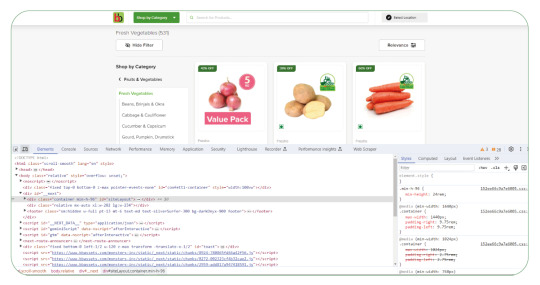
Choose the websites you want to scrape data from, in this case, BigBasket and Flipkart, as they are your target sources for grocery delivery information.
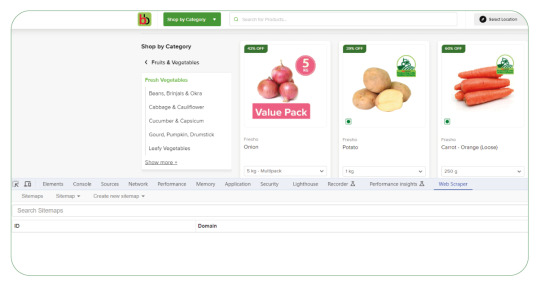
Decide on a grocery data scraper or library to use for data extraction. You can opt for tools like BeautifulSoup, Scrapy, or Selenium. Make sure to install and set up the chosen tool in your development environment.
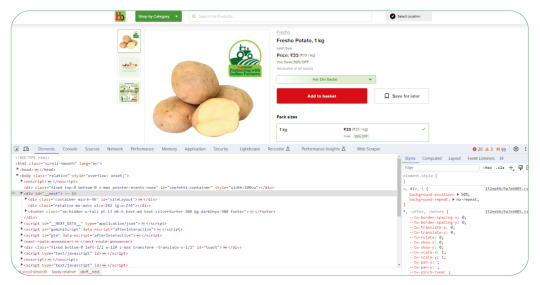
Clearly outline the specific data points you want to extract from BigBasket and Flipkart. It may include product names, prices, availability, customer reviews, and delivery information. Defining these data requirements will guide your scraping scripts.
4. Crawl the Websites:
Write web scraping scripts using the selected tool to crawl the websites. It involves navigating the web pages, locating the relevant data, and extracting it. Ensure that your scripts can handle the structure of these e-commerce websites.
5. Handle Data Extraction Challenges:
Be prepared to handle challenges that may arise during scraping, such as handling dynamic content (if any), handling CAPTCHAs, and managing website rate limits to avoid blockage.
6. Data Storage:
Store the scraped data in an organized format, such as a database, spreadsheet, or JSON file. It will make it easier to analyze and use the collected information.
7. Compliance with Ethical and Legal Standards:
Ensure your web scraping activities are conducted ethically and comply with legal standards. Respect the terms of service of BigBasket and Flipkart, avoid overloading their servers, and follow the guidelines outlined in their "robots.txt" files.
8. Data Analysis and Application:
Once you have successfully scraped the data, analyze it to gain insights into the grocery delivery market using grocery delivery data scraping services. You can use these insights to make informed business decisions, such as adjusting pricing, optimizing product offerings, and improving delivery services.
9. Regular Data Updates:
Consider implementing a mechanism for regularly updating the scraped data to keep your information current. It ensures you can always access the latest grocery delivery data from BigBasket and Flipkart.
At Product Data Scrape, we maintain the highest ethical standards in all operations, including Competitor Price Monitoring Services and Mobile App Data Scraping. With a global presence spanning multiple offices, we consistently deliver exceptional and honest services to meet the diverse needs of our valued customers.
#CollectRealTimeGroceryData#ScrapeBigBasketGroceryData#ScrapeFlipkartGroceryData#FlipkartDataScraper#GroceryDeliveryDataScraping#GroceryDataScraper#ScrapeRealTimeGroceryData
0 notes
Text
Tapping into Fresh Insights: Kroger Grocery Data Scraping
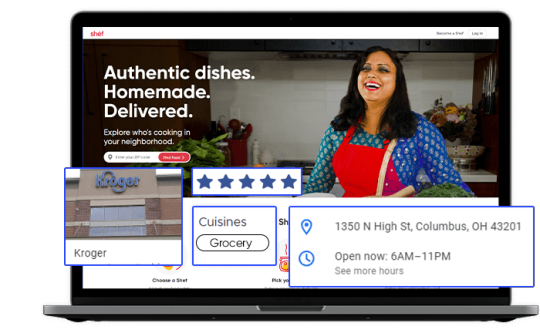
In today's data-driven world, the retail grocery industry is no exception when it comes to leveraging data for strategic decision-making. Kroger, one of the largest supermarket chains in the United States, offers a wealth of valuable data related to grocery products, pricing, customer preferences, and more. Extracting and harnessing this data through Kroger grocery data scraping can provide businesses and individuals with a competitive edge and valuable insights. This article explores the significance of grocery data extraction from Kroger, its benefits, and the methodologies involved.
The Power of Kroger Grocery Data
Kroger's extensive presence in the grocery market, both online and in physical stores, positions it as a significant source of data in the industry. This data is invaluable for a variety of stakeholders:
Kroger: The company can gain insights into customer buying patterns, product popularity, inventory management, and pricing strategies. This information empowers Kroger to optimize its product offerings and enhance the shopping experience.
Grocery Brands: Food manufacturers and brands can use Kroger's data to track product performance, assess market trends, and make informed decisions about product development and marketing strategies.
Consumers: Shoppers can benefit from Kroger's data by accessing information on product availability, pricing, and customer reviews, aiding in making informed purchasing decisions.
Benefits of Grocery Data Extraction from Kroger
Market Understanding: Extracted grocery data provides a deep understanding of the grocery retail market. Businesses can identify trends, competition, and areas for growth or diversification.
Product Optimization: Kroger and other retailers can optimize their product offerings by analyzing customer preferences, demand patterns, and pricing strategies. This data helps enhance inventory management and product selection.
Pricing Strategies: Monitoring pricing data from Kroger allows businesses to adjust their pricing strategies in response to market dynamics and competitor moves.
Inventory Management: Kroger grocery data extraction aids in managing inventory effectively, reducing waste, and improving supply chain operations.
Methodologies for Grocery Data Extraction from Kroger
To extract grocery data from Kroger, individuals and businesses can follow these methodologies:
Authorization: Ensure compliance with Kroger's terms of service and legal regulations. Authorization may be required for data extraction activities, and respecting privacy and copyright laws is essential.
Data Sources: Identify the specific data sources you wish to extract. Kroger's data encompasses product listings, pricing, customer reviews, and more.
Web Scraping Tools: Utilize web scraping tools, libraries, or custom scripts to extract data from Kroger's website. Common tools include Python libraries like BeautifulSoup and Scrapy.
Data Cleansing: Cleanse and structure the scraped data to make it usable for analysis. This may involve removing HTML tags, formatting data, and handling missing or inconsistent information.
Data Storage: Determine where and how to store the scraped data. Options include databases, spreadsheets, or cloud-based storage.
Data Analysis: Leverage data analysis tools and techniques to derive actionable insights from the scraped data. Visualization tools can help present findings effectively.
Ethical and Legal Compliance: Scrutinize ethical and legal considerations, including data privacy and copyright. Engage in responsible data extraction that aligns with ethical standards and regulations.
Scraping Frequency: Exercise caution regarding the frequency of scraping activities to prevent overloading Kroger's servers or causing disruptions.
Conclusion
Kroger grocery data scraping opens the door to fresh insights for businesses, brands, and consumers in the grocery retail industry. By harnessing Kroger's data, retailers can optimize their product offerings and pricing strategies, while consumers can make more informed shopping decisions. However, it is crucial to prioritize ethical and legal considerations, including compliance with Kroger's terms of service and data privacy regulations. In the dynamic landscape of grocery retail, data is the key to unlocking opportunities and staying competitive. Grocery data extraction from Kroger promises to deliver fresh perspectives and strategic advantages in this ever-evolving industry.
#grocerydatascraping#restaurant data scraping#food data scraping services#food data scraping#fooddatascrapingservices#zomato api#web scraping services#grocerydatascrapingapi#restaurantdataextraction
4 notes
·
View notes
Text
Extracting food delivery data is an obvious choice for businesses with access to this service and are interested in learning more. The data can offer insightful knowledge about demand, customer preferences and behaviors, and other essential details to give an advantage over competitors. Business owners may benefit from this kind of information when trying to improve their products and services. It's the best tool for developing pricing and marketing plans to stay competitive.
#fooddeliverydatascraping#webscraping#datascraping#dataextraction#scrapingfooddeliverydata#grocerydatascraping#restaurantdatascraping#competitiveanalysis#marketresearch#fooddeliveryapp
0 notes
Text

Web Data Crawler provides advanced Grocery Product Data Scraping solutions to help retailers optimize pricing and inventory. Our Real-Time Grocery Data Scraping ensures accurate stock tracking, reducing out-of-stock incidents. With Web Scraping for Inventory Management, businesses gain insights into competitor prices and demand trends. Our Grocery Delivery Data Extraction and Automated Stock Tracking for Grocery Retailers drive efficiency, improving margins and customer satisfaction.
#GroceryProductDataScraping#RealTimeGroceryDataScraping#WebScrapingForInventoryManagement#GroceryDeliveryDataExtraction#DataScrapingForGroceryECommerce#WebScrapingForGroceryStores#ScrapingGroceryDeliveryServicesData#AutomatedStockTrackingForGroceryRetailers#RealTimeProductStockScraping#GroceryDataAnalyticsSolutions#CompetitorPriceTrackingForGroceryStores#WebDataCrawler#GroceryDataScraping
0 notes
Text
How Can Amazon Fresh and Grocery Delivery Data Scraping Benefit in Trend Analysis?
In today's highly digitized world, data is the cornerstone of most successful online businesses, and none exemplify this better than Amazon Fresh and Grocery Delivery Data Scraping. As Amazon's grocery delivery and pick-up service, Amazon Fresh sets new standards in the online grocery retail industry, bringing the convenience of one-click shopping to perishable goods. With its data-driven approach, Amazon Fresh has redefined the grocery landscape, combining cutting-edge technology with supply chain efficiency to reach a broad audience. This approach has also fueled demand for Scrape Amazon Fresh and Grocery Delivery Product Data and similar grocery delivery services. Scraping, or the automated extraction of information from websites is a powerful tool in today's digital marketplace. When applied to platforms like Amazon Fresh, it opens up many possibilities for competitors, researchers, and marketers seeking valuable insights into trends, pricing, consumer behavior, and stock availability. With the help of Amazon Fresh and Grocery Delivery Product Data Scraping Services, businesses can leverage these insights to stay competitive, optimize inventory, and improve customer satisfaction in the rapidly evolving grocery industry.
The Growing Popularity of Online Grocery Shopping
Before delving into the specifics of Amazon Fresh and Grocery Delivery Product Data Extraction, it's essential to understand the broader online grocery delivery landscape. This market has seen exponential growth in recent years, primarily driven by changing consumer habits and the pandemic's impact on shopping behavior. Online grocery shopping has evolved from a niche offering to a mainstream service, with consumers now enjoying doorstep deliveries, same-day options, and subscription-based purchasing.
Amazon Fresh has played a pivotal role in this transformation. With its vast selection, competitive pricing, and logistical prowess, Amazon Fresh has rapidly scaled to become one of the dominant forces in the online grocery market. Its success has also underscored the importance of real-time data, which is vital for effective inventory management, dynamic pricing, and personalized recommendations. E-commerce Data Scraping has thus become an essential tool for businesses seeking to extract actionable insights from this data, enabling them to optimize their operations and improve their competitiveness.
As more retailers move into the grocery space, Amazon Fresh and Grocery Delivery Product Data Extraction remains at the forefront of innovations in the sector. It provides the data needed to understand customer preferences, monitor pricing trends, and adjust inventory in real-time. This ongoing evolution highlights the critical role that data scraping plays in ensuring that businesses stay ahead in an increasingly digital world.
Importance of Scraped Data in E-commerce and Grocery Delivery
In e-commerce, data is not just a byproduct; it's the product. Businesses leverage data to make critical decisions, streamline operations, enhance customer experience, and boost revenue. For online grocery services, data is especially critical, given the time-sensitive nature of perishable goods, fluctuating consumer demand, and competitive pricing strategies.
Platforms like Amazon Fresh constantly monitor stock levels, customer preferences, and seasonal trends to deliver a seamless experience. Data also enables these platforms to offer dynamic pricing, a technique where prices fluctuate based on demand, competitor pricing, and stock availability. As a result, competitors, third-party sellers, and market analysts are increasingly interested in Amazon Fresh and Grocery Delivery Product Data Collection to monitor these variables in real-time. This data can be used for various purposes, such as optimizing pricing, improving product offerings, and enhancing delivery strategies. To gain a competitive edge, many businesses turn to Pricing Intelligence Services, which uses scraped data to track price changes, identify patterns, and adjust their pricing strategies to match or outpace Amazon Fresh's dynamic pricing model.
What is Amazon Fresh Data Scraping?
Amazon Fresh data scraping involves the automated extraction of information from Amazon's grocery platform. Using web scraping tools and techniques, data from Amazon Fresh can be collected, organized, and analyzed to gather insights on various parameters, including product pricing, customer reviews, best-selling items, and delivery availability. This data can be used for various applications, such as competitive analysis, market research, trend forecasting, and inventory planning.
For instance, businesses can scrape product prices on Amazon Fresh to ensure their pricing remains competitive. Retailers can also gather product availability and delivery times data to monitor supply chain performance and consumer satisfaction levels. Additionally, customer reviews provide a wealth of information on consumer sentiment, enabling companies to adjust their product offerings or marketing strategies accordingly. The gathered data can be compiled into Amazon Fresh and Grocery Delivery Product Datasets, which provide actionable insights across various business functions. By utilizing this data, businesses can implement Price Optimization for Retailers, ensuring they stay competitive in an ever- changing marketplace and align with consumer expectations.
Key Data Points for Amazon Fresh and Grocery Data Scraping
Several valuable data points can be obtained through Web Scraping Amazon Fresh and Grocery Delivery Product Data, each providing unique insights into consumer behavior, market trends, and competitive positioning. Some of the most sought-after data points include:
1. Product Pricing: One of the primary drivers of consumer decision-making, product pricing data allows businesses to assess Amazon Fresh's pricing strategies and adjust their pricing to stay competitive. With real-time price scraping, businesses can identify price changes instantly, helping them respond more effectively to market fluctuations.
2. Product Availability: Monitoring product availability on Amazon Fresh provides insights into inventory levels and stock turnover rates. For companies involved in logistics or supply chain management, understanding Amazon's inventory trends can reveal valuable information about consumer demand and purchasing patterns.
3. Customer Reviews and Ratings: Reviews and ratings are a rich data source for businesses looking to improve their offerings. By analyzing reviews, companies can identify common issues, consumer preferences, and potential areas for improvement in their products or services.
4. Delivery Times and Options: Scraping data on delivery times, availability of same- day delivery, and delivery fees can offer insights into Amazon Fresh's logistical capabilities and customer expectations. This data is invaluable for companies looking to match or improve Amazon Fresh's delivery performance.
5. Best-Selling Products: Knowing which items are most popular on Amazon Fresh allows companies to identify trends in consumer demand. This information can inform product development, marketing strategies, and stocking decisions.
6. Promotional Offers and Discounts: Scraping information on discounts and promotions can reveal Amazon Fresh's pricing and marketing strategies. Competitors can use this information to create similar promotions, ensuring they stay relevant in a highly competitive market.
Benefits of Data Scraping for Amazon Fresh and Grocery Delivery Analysis
Scraping Amazon Fresh data provides several significant advantages to businesses in the grocery delivery sector. By extracting and analyzing data, companies can gain insights that would be difficult or impossible to obtain through manual observation. The benefits include:
1.Competitive Intelligence: By analyzing Amazon Fresh's product offerings, pricing strategies, and delivery performance, competitors can make informed decisions that enhance their operations. For example, a grocery retailer might adjust its pricing or delivery times to offer a more attractive service than Amazon Fresh. Utilizing an Amazon Fresh and Grocery Delivery Product Scraping API can help streamline this process by automating the extraction of large volumes of competitive data.
2.Market Insights and Trend Analysis: Data scraping lets companies stay updated on the latest market trends and consumer preferences. With accurate data, businesses can anticipate shifts in consumer demand, enabling them to adjust their product offerings or marketing strategies proactively. Tools like the Amazon Fresh and Grocery Delivery Product Data Scraper allow companies to track real-time changes, ensuring they are always ahead of the curve.
3.Pricing Optimization: Real-time pricing data allows businesses to optimize their pricing strategies. By tracking Amazon Fresh's prices, companies can identify patterns in price fluctuations and set their prices accordingly, maximizing revenue without compromising competitiveness. Scrape Amazon Fresh and Grocery Delivery Search Data to gather this pricing information, which can be critical for adjusting prices dynamically.
4.Improved Customer Experience: Understanding consumer sentiment and product preferences through reviews and ratings enables businesses to improve the customer experience. Companies can build a loyal customer base by addressing common pain points and meeting customer expectations. Retail Website Data Extraction enables businesses to capture customer feedback from various product pages, making it easier to refine their offerings based on real-time insights.
5.Inventory Management: Analyzing product availability and stock turnover rates can help businesses fine-tune their inventory management processes. Companies can make more accurate forecasting and replenishment decisions by knowing which items are in high demand or likely to go out of stock. Data scraping tools can help track stock levels on Amazon Fresh, providing actionable information for inventory planning.
6.Informed Product Development: Amazon Fresh data scraping insights can guide product development efforts. For example, if certain organic products are trendy, a retailer might consider expanding its range of organic offerings to meet consumer demand. With an automated scraping solution, businesses can efficiently gather data on trending products to inform these strategic decisions.
Ethical and Legal Considerations in Data Scraping
While data scraping provides many benefits, it also raises important ethical and legal considerations. Amazon's terms of service prohibit unauthorized data scraping, and violating these terms could lead to legal action. Companies must, therefore, be cautious and ensure that their data scraping practices comply with legal requirements:
Some ethical considerations include respecting user privacy, avoiding excessive server requests, and ensuring data is used responsibly. To stay compliant with legal frameworks, businesses may opt for alternatives to traditional web scraping, such as APIs, which provide a legal and structured way to access data. These alternatives, including Product Matching techniques, help businesses align their data collection efforts with Amazon's guidelines while gaining valuable insights. Additionally, Price Scraping can be carried out responsibly by using official API access, ensuring that businesses gather pricing information without overburdening servers or violating terms of service.
In addition to scraping and API use, companies are also exploring data partnerships, which allow them to obtain valuable data insights without infringing on Amazon's policies. This collaboration helps businesses access real-time product and pricing data while maintaining legal and ethical standards.
Future Trends and Innovations in Grocery Data Scraping
Advances in artificial intelligence and machine learning will likely shape the future of grocery data scraping. These technologies allow for more sophisticated data extraction and analysis, enabling companies to derive deeper insights from Amazon Fresh data. AI-powered tools can automatically identify patterns and trends, providing businesses with valuable intelligence for Competitive Pricing Analysis and optimizing their pricing strategies. As the online grocery market grows, data scraping tools will likely become more specialized, focusing on specific areas such as product recommendation analysis, demand forecasting, and sentiment analysis.
Advances in artificial intelligence and machine learning will likely shape the future of grocery data scraping. These technologies allow for more sophisticated data extraction and analysis, enabling companies to derive deeper insights from Amazon Fresh data. AI-powered tools can automatically identify patterns and trends, providing businesses with valuable intelligence for Competitive Pricing Analysis and optimizing their pricing strategies. As the online grocery market grows, data scraping tools will likely become more specialized, focusing on specific areas such as product recommendation analysis, demand forecasting, and sentiment analysis.
Another trend to watch is the integration of blockchain technology for data verification. Blockchain can ensure the authenticity and accuracy of scraped data, offering greater transparency and trustworthiness in data-driven decision-making. By leveraging blockchain, businesses can verify the integrity of their Online Retail Price Monitoring data, providing them with more reliable insights for pricing adjustments and product positioning.
Conclusion
Amazon Fresh and grocery delivery data scraping are transforming how businesses approach competitive analysis, consumer insights, and market trends. With the right tools and practices, companies can harness the power of data to stay competitive in the rapidly evolving online grocery market. Utilizing eCommerce Scraping Services allows businesses to gain a competitive edge while remaining informed about changing market dynamics. However, it is essential to approach data scraping responsibly, balancing the desire for insights with respect for ethical and legal boundaries. By doing so, businesses can unlock the full potential of Amazon Fresh data scraping, creating a more data-driven and consumer-focused grocery delivery ecosystem.
Transform your retail operations with Retail Scrape Company's data-driven solutions. Harness real-time data scraping to understand consumer behavior, fine-tune pricing strategies, and outpace competitors. Our services offer comprehensive pricing optimization and strategic decision support. Elevate your business today and unlock maximum profitability. Reach out to us now to revolutionize your retail operations!
Source: https://www.retailscrape.com/amazon-fresh-and-grocery-delivery-data-scraping.php
0 notes
